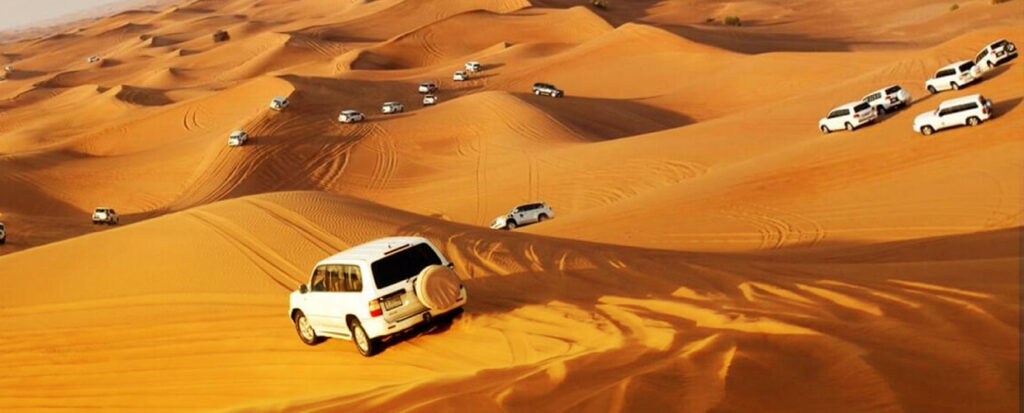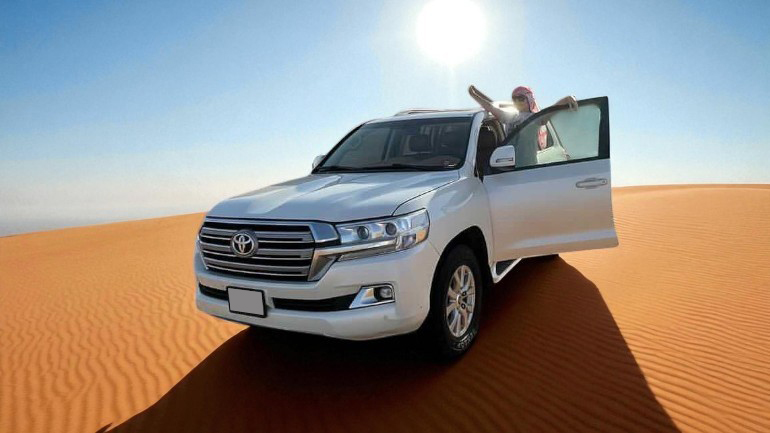While a Private Desert Safari Dubai offers a great chance for off-roading adventure in the wilderness, where you get to spend quality time away from city noise and bustle, you can also test your photography skills to capture the region’s beauty, tranquility, and cultural richness through your lens.
Such photographs also remind you of your wonderful time and tempt you to go back and experience it again. We have prepared this guide to help you capture the best pictures of your safari trip, including locations, timings, and necessary equipment. So stick with us till the end as we help you become a professional photographer.
Preparing For Desert Safari Photography
First, let’s talk about preparing for photography. We will start with the equipment needed and its purpose. We believe a standard photography kit can be applied to almost any environment you intend to shoot. Adding fine-tuned accessories depending on the conditions will be the only difference.
In the desert, you can photograph everything you wish if you have a camera with multiple lenses covering various focal lengths. Here are the items we recommend you bring on your private desert safari Dubai trip. We have listed my basic kit and a few extra things you can bring on your desert trip.
Some of these measures include protecting your camera. The harsh environment in the desert can damage your camera in many ways, so it is important to learn how to keep it safe and prevent sand from entering.
Here is a list of standard camera equipment for your safari tour. You don’t have to bring all of them, just consider only those you think will be useful.
The main camera body plus a spare body
Having a spare camera body is important to ensure that you don’t face any difficulty in case your main camera experiences technical issues or major faults.
Fast wide angle lens (16-28mm f2.8)
A wide-angle lens helps capture the expansive desert region in a 150-180-degree photo. A 16-28mm lens is helpful in low-light situations, which will likely develop around the evening and at night if you have booked a safari tour.
Mid-range “walkaround lens” (24-70mm)
This lens type covers a wide range of focal lengths that help capture wide landscapes of the region and portrait shots of a person.
Zoom lens with telephoto capability (70-300mm)
These lenses help capture distant shots. For example, if you want photographs of wildlife animals or camel caravans far from you, you can’t go near them.
Tripod
A tripod is vital for capturing stable, long-exposure shots. Further, they also help in astrophotography, which you can do on your overnight desert safari trip when the sky is crystal clear.
UV filters
These filters help safeguard the front glass element of your lenses against dust, sand, and potential scratches, which are likely to happen in a desert environment. Further, they also help reduce UV haze in bright conditions.
Graduated Neutral Density Filters
These filters help you balance exposure in scenarios with a significant difference between bright and dark areas. If you photograph a dark desert region in bright sunlight, use graduated neutral density filters.
Polarising filter
A polarizing filter helps in reducing reflections and glare during daytime conditions.
Remote shutter release
This remote shutter control enables you to capture camera shots without touching the button. It is helpful when you need camera stability for certain shots, like long exposure.
Two spare batteries
Extra batteries ensure you don’t run out of power during your photography session. Also, there is little to no power in desert areas, so charging the existing batteries is impossible.
Spare SD or CF Cards
Additional memory cards provide extra storage for high-resolution photos and ensure you never run out of storage.
Lens Cleaning Kit
Dust and sand can accumulate on your lenses in desert environments, so a cleaning kit is essential for maintaining image quality.
Rain cover
Although we cannot expect much rain in the desert if the weather predictions are there, a rain cover comes quite handy in protecting the camera equipment.
Plastic tarp
You may often have to lay the camera bag on the desert ground to relax or take a small break, and desert debris could damage the bag. However, if you lay your bag over, a plastic tarp prevents all that.
Old Shirt or Towel
Wrap the camera with a towel or shirt when not used. This keeps dirt and sand off.
Flashlight and headlamp
These light sources are very useful for exploring the desert at nighttime and setting up your equip

Choosing the Best Camera for Safari Tours
When choosing the camera for your desert safari tour, we recommend you consider portability as it must be easy to carry everywhere and durability to handle tough desert conditions. Here are some famous options.
DSLR cameras
DLSR cameras are the most popular choice by many professional photographers. These help you capture the wide desert landscapes. Also, they have the best auto-focus features for capturing fast-moving objects at high quality. These are a little expensive but are with it.
Action cameras
Action cameras come quite handy for photographing fast adventure activities like dune bashing, quad biking, or sandboarding.
Mobile Phone Camera
A mobile phone camera can also capture the best photos if you don’t have a DSLR or are not a professional photographer. The latest Google Pixel and iPhone models can capture images that match the quality of DSLR.
GoPro Camera
A GoPro camera helps you capture sports activities like dune bashing, quad biking, and dune buggy riding. These cameras can be easily attached to the vehicle and record the tour so you can watch and reminisce about it later.
Camera Settings For Safari Photoshoot
The following are camera settings for capturing the best shots on your desert safari.
Sensitivity Control – ISO
The ISO setting should be between 100 and 400, ideally. A higher ISO might be tempting in low light but can produce grainy photographs. You should use the lower end of the scale when the sun is shining brightly to maintain the quality of your images.
Aperture – Mastering Depth of Field
To achieve a blurred background and a sharp focus on your subject, choose a smaller f-number (like f/4 or f/2.8). Use this technique for portrait shots or when you wish to highlight one particular object.
Shutter speed – Freezing a moment in time
A crystal-clear image is produced if your shutter speed is faster, such as 1/1000th of a second, which will freeze fast action such as dune bashing or camel running. However, a slower shutter speed can add a sense of movement to ethereal, flowy shots of sand.
Color Management – White Balance
There is a possibility that your photos will appear too warm or too blue in the desert. It is possible to adjust the white balance on most modern cameras. If you prefer a warmer hue, select ‘Cloudy’ or ‘Shade’ for a balanced hue.
Compensation for exposure – optimizing brightness
Occasionally, the vast expanses of desert sand can cause your camera to underexpose the image, which results in a dark image. You can brighten the image manually by using the Exposure Compensation feature on your camera. Set it to +0.5 or +1 and adjust it as necessary.
Different Strategies and Timings for Desert Safari Photoshoot
The Golden Hour
It is best to photograph deserts during the ‘Golden Hour,’ which occurs shortly after sunrise and before sunset. As the sun sets over the landscape, the golden hues of the sky create soft shadows and an atmosphere of magic. Be prepared by setting up your camera settings and choosing the location so that you can take photographs when the right moment arises.
Experiment with different angles
Although it may seem appealing to photograph the desert landscape straight on, this often produces flat, uninspiring photographs. Different angles can add energy to your pictures. Shoot from a high vantage point to emphasize the grandeur of the dunes or crouch low to capture the texture of the sand. If you wish to capture a unique angle, tilt your camera slightly.
Playing with shadows
As the desert sun shines, long, stretching shadows can be created, adding depth and patterns to your photographs. Take advantage of these natural lines by positioning the subject, whether a person or an object such as a camel. Using shadows to direct the viewer’s attention, evoke mystery, or even produce an artistic effect is possible.
Lighting from behind
The best silhouettes are created by positioning your subject between the sun and the camera. This technique emphasizes shapes and creates an atmosphere of drama. Backlighting poses a particular challenge when capturing the right exposure, so be mindful of your camera settings.
A Reflective Surface
During your safari, you’ll often see reflective surfaces in the desert, like pools of water after a rare rain or shiny vehicles. Reflect light onto these surfaces to soften harsh shadows and reveal hidden details. This can be particularly effective during midday when sunlight is most harsh.
Capturing Details in the Dunes
You can try to zoom in and grab the fascinating details on dunes that we might call a ‘Macro Shot. ’ You can use a macro lens for this purpose or use Macro mode on your camera. You can find many ripples and patterns in a close-up shot of a dune, creating stunning photos.
Night-time Photography
If you have booked an overnight desert safari, clear desert skies offer the best opportunity for astrophotographs of stars, the moon, and the Milky Way Galaxy. Use a tripod to position your camera at the best angle and a wide aperture lens to capture stunning nighttime photos.
Photographing Candid Moments
Photograph the candid moments of your private desert safari Dubai trip. This includes capturing your fellow travelers’ joy and group interactions with guides and locals. A candid photograph captures the essence of an adventure.

Capturing Wildlife on Your Camera
Several wildlife species in the Dubai desert include Arabian oryx, gazelles, and birds. To capture these species, follow the tips below:
Respect Wildlife and keep a distance
Keep a safe distance from animals and refrain from startling or hurting them.Telephoto lenses are useful for taking close-up photographs of these animals without entering their habitat.
Be patient and wait for the right time
Wildlife photography requires a high level of patience as well as time. You must wait patiently to capture the perfect moment when an animal is doing any activity worth capturing. Observe them closely and keep your camera ready.
Use the burst mode on your camera
If you want to capture images of fast-moving wildlife or action during an activity such as falconry displays, the burst mode on your camera can prove handy.
Etiquette for Photographing in The Desert
During your photography session on your Dubai Desert Safari Tour, you must be respectful of other people and follow these guidelines:
Respect fellow safari participants’ privacy
Remember to seek permission from your fellow tourists before taking their photographs. Ask them in person if you can photograph them, and if possible, send them a copy of their photos in private after the tour.
Minimize disturbance
Pay attention to the surroundings and do not create unnecessary commotion that may disturb the tranquil atmosphere of the desert.
Educate each other
To foster a supportive community, provide tips and guidance to fellow photographers who are less experienced.
Conclusion
You do not have to be a magician to capture the perfect shot during your Desert Safari Dubai. Using the right camera settings and poses, even novice photographers can create photos that will make their friends green with envy. So grab your camera, book your desert safari tour now, and head there.
For early booking and more information on desert safari packages, contact Private Desert Planet Tourism LLC. Also, we offer professional photography as a part of packages if you feel interested.

Bilal Mohsin



Latest posts by Bilal Mohsin (see all)
- How to Book Desert Safari Dubai in 2025: Easy Online Guide & Insider Tips - August 15, 2025
- Desert Safari Dubai Price Guide 2025: Latest Deals & What’s Included - August 13, 2025
- Dubai Desert Safari 2025: Top Rated Experiences & Best Tour Packages - August 12, 2025






